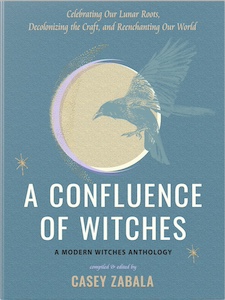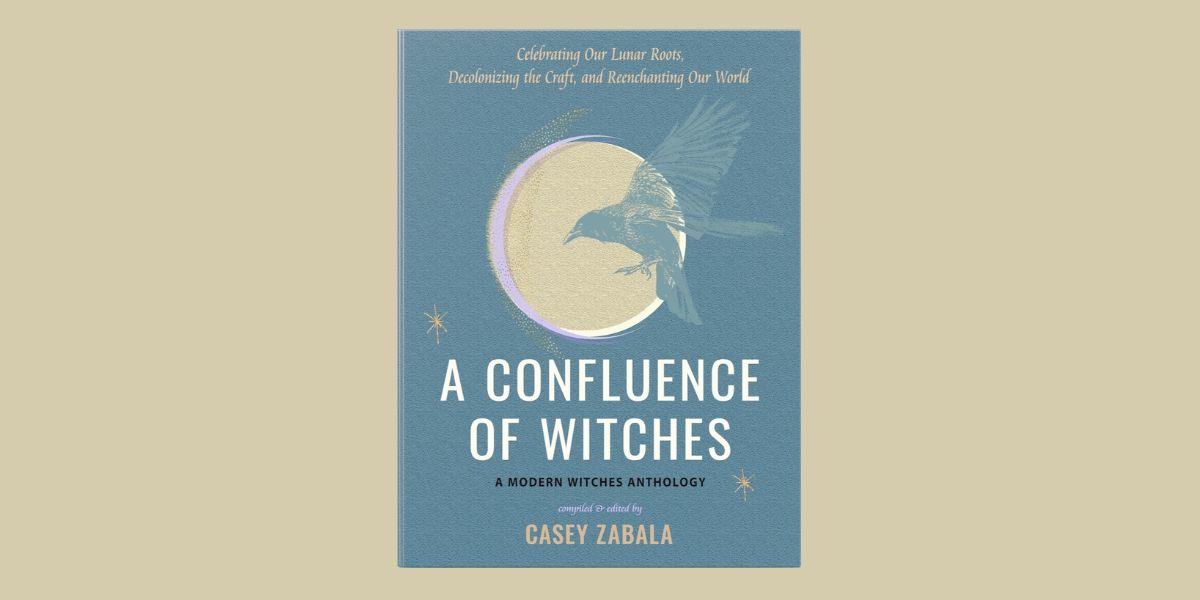
A Confluence of Witches: Celebrating Our Lunar Roots, Decolonizing the Craft, and Reenchanting Our World, edited by Casey Zabala
Weiser Books, 1578638453, 224 pages, October 2024
Witchcraft is not a one-size-fits-all practice. There’s no single, universal “witchcraft” that everyone follows. Different witches may have varying beliefs, rituals, and traditions, influenced by their individual experiences, cultural backgrounds, and personal paths. This diversity is what makes witchcraft such a rich and fascinating exploration.
A Confluence of Witches: Celebrating our Lunar Roots, Decolonizing the Craft, and Reenchanting Our World, edited by Casey Zabala, brings together a diverse array of voices within the contemporary witchcraft community. Through a rich tapestry of essays, rituals, and personal narratives, this anthology shines a light on the multifaceted nature of witchcraft in the modern world to explore “the authentic intersection of magic, spirituality, personal development, and social justice.”1
“Modern Witchcraft is not a disavowal of our Pagan, animist, lunar roots. Rather, Modern Witchcraft is an evolution of our responsibilities as practicing witches. These responsibilities have historically been to praise the divinity of the Earth and cosmos, to provide healing remedy and support to the community, and to offer a spiritual framework for the oppressed. To be a modern witch we must straddle both our ancient origins and our futurist dreams.”2
This anthology covers a broad range of topics that will appeal to both seasoned practitioners and those new to the craft. The seven chapters each focus on a certain aspect of witchcraft: the Moon, the blending of traditional magic with modern technology, the decolonization of witchcraft, connection with the spirit world, connection to our bodies and Earth, pathways of healing, and the power of covens. Within the chapter there’s three essays related to the topic.
The essays in A Confluence of Witches are thought-provoking and deeply personal. Each contributor shares their unique journey and insights, making the anthology both informative and intimate. Some of my favorites are “Reclamining Resources: Money Magic in This Time of Capitalism” Jessie Susannah Karnatz, “Loving What Is: Quantum Witchcraft” by Sanyu Estelle, “Flower Animism: A Floral Spell” by Liz Migliorelli, and “There is Sustenance in the Roots by Star Feliz.
Zabala’s editorial hand is evident in the seamless flow of the book. At the start of each chapter, she writes an introduction for the topic, creating a cohesive overview of the essays that follow. I also felt like the arrangement of the chapters was very intuitive, though there’s truly no need to read them all in order.
One of this anthology’s greatest strengths is its inclusivity. Zabala has curated contributions from witches of various backgrounds, practices, and traditions, ensuring that readers are exposed to a wide spectrum of perspectives. This diversity not only enriches the reader’s understanding of witchcraft but also challenges any preconceived notions they might have. The essays all give a little glimpse inside the world of the writers, so readers can then pursue exploring more work of the writers they especially resonate with.
There are so many leads I want to follow now that I’ve read this book! I am truly enamored with the insights from the writers who contributed. At the end, Zabala has included biographies for all the contributors. Here readers can discover new podcasts, YouTube channels, books, organizations and groups, and more. The community Zabala created in 2018 is called Modern Witches, which aims “to heal and honor the collective’s relationship to the witch.”3
Reading through this book prompted a lot of reflection for me, and I began to see my practice connected to a much wider group of people. Oftentimes, especially when feeling isolated or marginalized, I think witches forget the community resources available to them. But there are so many others out there shaping Modern Witchcraft. I learned about so many other amazing witches and their work when reading this book that I would have never known about otherwise, and I’m really excited to further brand out and explore some new groups I learned about from the book.
It felt very expansive to see just how vast the world of Modern Witchcraft is right now and to take the time to think about the impact of technology, political systems, and social structures on witchcraft right now. With each chapter, I felt a shimmering web of energy growing between me and these other witches; even though our practices might look very different, we all walk the same path at this current time.
Overall, A Confluence of Witches is an essential read for anyone interested in the Modern Witchcraft movement. Within the variety of voices, the book maintains a narrative that guides the reader through the complexities of Modern Witchcraft that is expansive, inclusive, and thought-provoking. Whether one is new to the craft or a seasoned practitioner, this book gives voice to where Modern Witchcraft is at right now, contextualizing the greater community of witches beyond one’s daily scope.
We all possess our own sacred blend of spirituality, shaped by our experiences, beliefs, and connections to the world around us. By embracing the diversity of witchcraft and honoring the unique practices of others, we can create a more inclusive and supportive community that celebrates the richness of human spirituality.
Alanna Kali is an astrologer, numerologist, and pioneer spirit that loves to explore life through the lens of depth psychology. She has a passion for studying the humanities and social trends. Her academic work is centered upon reuniting body, mind, and spirit through eco-psychology. She loves reading, spending time in nature, and travel.
